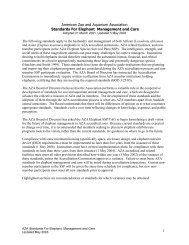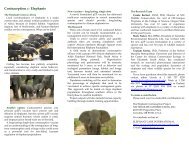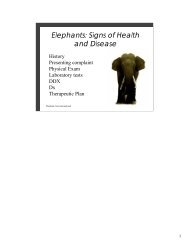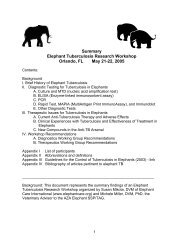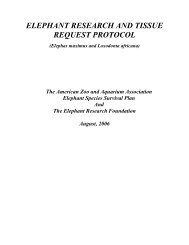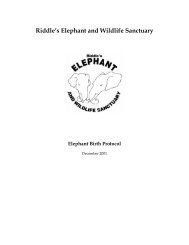Nepal Elephant TB Control and Mgt Action Plan.pdf - Elephant Care ...
Nepal Elephant TB Control and Mgt Action Plan.pdf - Elephant Care ...
Nepal Elephant TB Control and Mgt Action Plan.pdf - Elephant Care ...
- No tags were found...
Create successful ePaper yourself
Turn your PDF publications into a flip-book with our unique Google optimized e-Paper software.
<strong>Nepal</strong> <strong>Elephant</strong> Tuberculosis ulosis<strong>Control</strong> <strong>and</strong>Management agemen<strong>Action</strong> <strong>Plan</strong> (2011-2015)2015)1.1 IntroduconBackground<strong>Elephant</strong>s belong to the Family Eleph<strong>and</strong>ae inanimal kingdom <strong>and</strong> are the largest mammaliansamong terrestrial animals. <strong>Elephant</strong>s are believedto have evolved some 50 million years ago. Outof about 350 species under 44 Genera of thisfamily, only two genera (Elephas <strong>and</strong> Loxodonta)<strong>and</strong> three species remain today – the Asianelephant (Elephas maximus), the African bushelephant (Loxodonta africana), <strong>and</strong> the Africanforest elephant (Loxodonta cyclo!s). The Asianelephants are distributed in 13 Asian countries:<strong>Nepal</strong>, India, Bhutan, Bangladesh, China,Myanmar, Thail<strong>and</strong>, Indonesia, Laos, Vietnam,Cambodia, Malaysia, <strong>and</strong> Sri Lanka.Taming of Asian elephant began in the Indusvalley (now in Pakistan) around 4,000 yearsago. Taming of elephants was done for variouspurposes. <strong>Elephant</strong>s were trained <strong>and</strong> usedin warfare in India, China <strong>and</strong> Persia over thecenturies. In the past, elephants were extensivelyused across their range in mber industries,parcularly in logging <strong>and</strong> li!ing large logs, <strong>and</strong>safari hunng. Today, elephants in south <strong>and</strong>south-east Asia are used in tourism <strong>and</strong> protectedarea management. In some places, elephants aresll used in circuses because of their ability tobe trained to perform, <strong>and</strong> also because of theirimpressive size. <strong>Elephant</strong>s in Hindu communiesare regarded as a symbol of Lord Ganesh.In <strong>Nepal</strong>, elephants were used for Royal hunngsafaris for Royalty. <strong>Elephant</strong>s were also keptprivately <strong>and</strong> were used as a symbol of status <strong>and</strong>means of transportaon. A!er the creaon of theProtected Areas, elephants have been extensivelyused in patrolling, surveillance, research <strong>and</strong>monitoring, means of transportaon <strong>and</strong> wildlifetourism. Wild elephants in <strong>Nepal</strong> are confinedin the protected areas mainly in SuklaphantaWildlife Reserve, Bardia Naonal Park, ChitwanNaonal Park, Parsa Widlife Reserve, <strong>and</strong> nearbyforest areas. However, elephants from the WestBengal State of India frequently visit the forestareas in Jhapa, Morang, Udayapur <strong>and</strong> SunsariDistricts in the eastern lowl<strong>and</strong>. A low numberof private elephants are also reported fromKapilbastu, Rautahat <strong>and</strong> Sunsari Districts.<strong>Elephant</strong>s are prone to various infecous diseasesincluding tuberculosis, anthrax, haemorrhagicsepcaemia, foot-<strong>and</strong>-mouth disease, rabies,tetanus, encephalomyocardis virus, pox,salmonellosis, elephant endotheliotropic herpesvirus infecon, <strong>and</strong> others. Among these,tuberculosis (<strong>TB</strong>) is a chronic, debilitang diseasethat affects capve elephants world-wide. <strong>TB</strong> is athreat to capve elephants, wild elephants, otherwild <strong>and</strong> capve animals, <strong>and</strong> humans.<strong>TB</strong> was first idenfied in capve elephants in<strong>Nepal</strong> in 2002 (Gairhe 2002). Between 2002 <strong>and</strong>2009, there were seven deaths in which <strong>TB</strong> wasdiagnosed among government <strong>and</strong> NTNC-ownedelephants. Surveillance for <strong>TB</strong> in elephants in2




